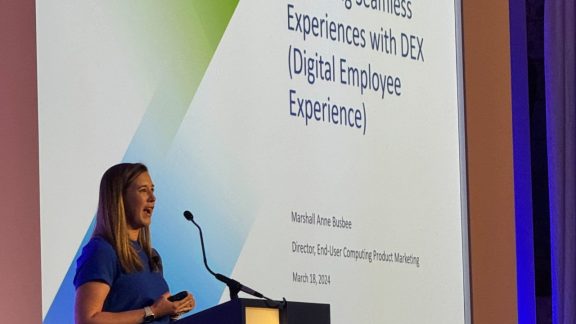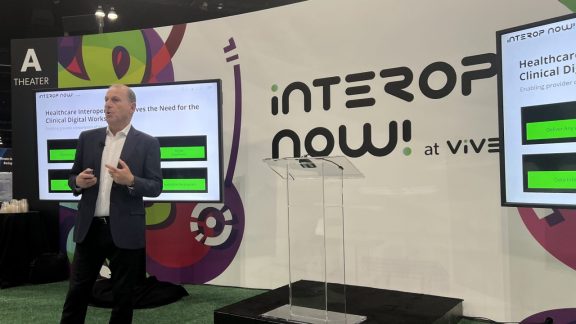By Warren Ponder, director, Product Management, End-User Computing, VMware
As the post PC-era continues to settle in, everyday it becomes more evident; how user work, how we access data, what applications we use and the devices we use to do so, is changing. It is not as much about what we do, but how we do it that is changing. User types are becoming more clearly apparent such as tethered users; user who work in a traditional office space daily with an assigned location and users who increasingly are becoming more mobile.
The challenge this creates for IT organizations is how they adapt to the changing landscape, transition and maintain the legacy services and managing their environments as efficiently as possible while delivering the maximum value to their end users.
VMware View 5, announced today at VMworld 2011 in Las Vegas, further builds and expands on providing this capability to IT organizations as they transform legacy PC services into end-user computing cloud services. With VMware View 5 a new level of services are now possible, allowing organizations to take the next step toward transitioning more use cases toward end-user cloud services.
End-User Device Choice:
End users now have more client choice for the devices they choose than ever before. With a broad array of over 214 certified client devices from our partner ecosystem for View, in addition to our traditional Windows based clients; mobile clients are now available for both Apple iOS and Android.
Richer graphics experience:
Together, VMware View and vSphere 5 deliver a uniquely differentiated graphics capability. This unique capability is targeted Task Workers or Knowledge users who want the Windows Aero experience or have basic 3D applications that require Direct-X or OpenGL support. It’s now possible to deliver both the Windows Aero experience and Basic 3D applications without requiring any specialized graphics or server hardware or any dependencies on the client end point
Without any client side dependencies it’s possible to support a wide array of clients such as Windows, Linux, Mobile, and Zero Clients. This new capability supports up dual displays up to 1900×1200 with acceptable performance across a WAN up to 100ms.
Above is a sample screenshot of my primary Windows 7 based desktop from our VMware View deployment at VMware that I primarily work from even from my home office away from Palo Alto. I have been allocated a 3D enabled desktop, 1 vCPU with 2GB RAM. I keep trying to muscle a 2 vCPU VM out of them, but honestly, this View desktop configuration more than satisfies my requirements.
Media Services – Unified Communications:
Through strategic partnerships we have closely been working with key industry leaders to bring Unified Communications integration and support to View from best of breed, market leading partners. By closely working with leaders in the Unified Communications space have been able to come up with a unique highly saleable solution for integrating rich interactive media services including voice and video. Read more about Unified Communication with VMware View and check out a video here.
Enhanced end user experience:
Though our continued collaboration and co-development of PCoIP, several end-user experience enhancements are available for PCoIP. I touched on some of these in my earlier blog. Three new protocol enhancements are being introduced. The first is the addition of client side caching. Client side caching leverages the intelligence of PCoIP to cache desktop composition and images on the client. The benefit is displaying portions of the session from a local client cache, rather than always retransmitting pixels across the network.
The second addition is a change to the lossless CODEC used for text such as ClearType and Anti-Alias fonts. ClearType fonts have historically been bandwidth heavy. This new optimization reduces the bandwidth consumed by more rich text types.
The third addition is the addition of a GPO policy that allows customers to disable build to lossless. PCoIP pioneered the delivery of the most demanding graphical workloads often found in extreme workstation class use cases. A key component of it unique capability to meet the needs of these demanding users is its ability to deliver a fully lossless experience. This capability has been key to the success we have seen across industries such as Healthcare where image quality is often more critical than strictly bandwidth usage. For use cases such as task workers and knowledge users where bandwidth is more critical than image quality administrators now have the option to disable build to lossless for additional bandwidth savings.
Based on our own internal tests, when combined these settings can result in up to 75% bandwidth savings. Naturally, results will vary across use cases and workloads. Several performance optimizations were also made resulting in a 5-10% CPU usage reduction.
View Persona Management:
View Persona Management preserves user profiles and dynamically synchronizes them with a remote profile repository. By preserving the user's profile between sessions, View Persona Management enables IT administrators to provide a floating pool to users who previously required their own dedicated desktop. Read more about View Persona Management here.
End user Experience Monitoring:
This adds detailed and granular real time monitoring capabilities of PCoIP sessions. This allows administrators to quickly identify problems, troubleshoot issues and better understand trends. A total of 31 individual statistics are available. Statistics are WMI based for flexible integration with existing monitoring tools. A future version of vCenter Operations and several VMware View ecosystem partners have integrated these statistics with their products to provide robust easy to use
The chart below is a snapshot of a Windows Aero based virtual machine hosted from a datacenter in Washington State accessed across the WAN from Boise Id.
Chart shows… avg. TX BW Kbps is 96Kbps; avg latency of the connection is 91ms
VMware View 5 Advances User-Centric Computing Model Enabling a Better Desktop:
As you can tell, we are pretty excited about the value VMware View 5 will deliver customers. It promises to help IT organizations empower a more agile, productive and connected enterprise. VMware View 5 further expands the addressable use cases as customer’s shift their focus away from traditional PC deployments of the past, and accelerate their journey with VMware to the cloud.
Let us know if you have any questions via the comments section this blog. We will do our best to respond quickly.
Read the VMware View 5 Media Backgrounder here. Screen Shots of View 5 can be found here.







